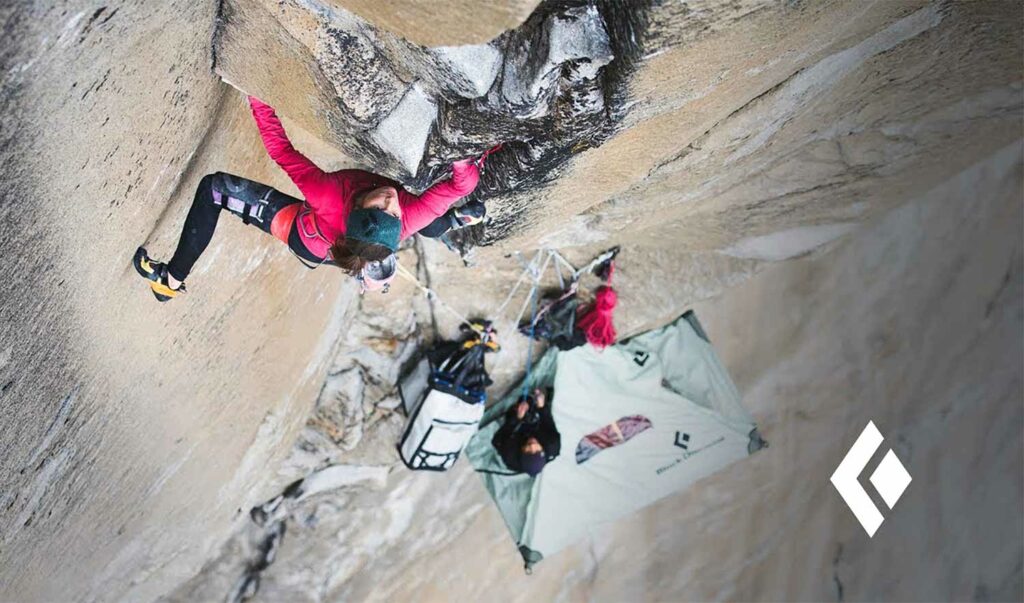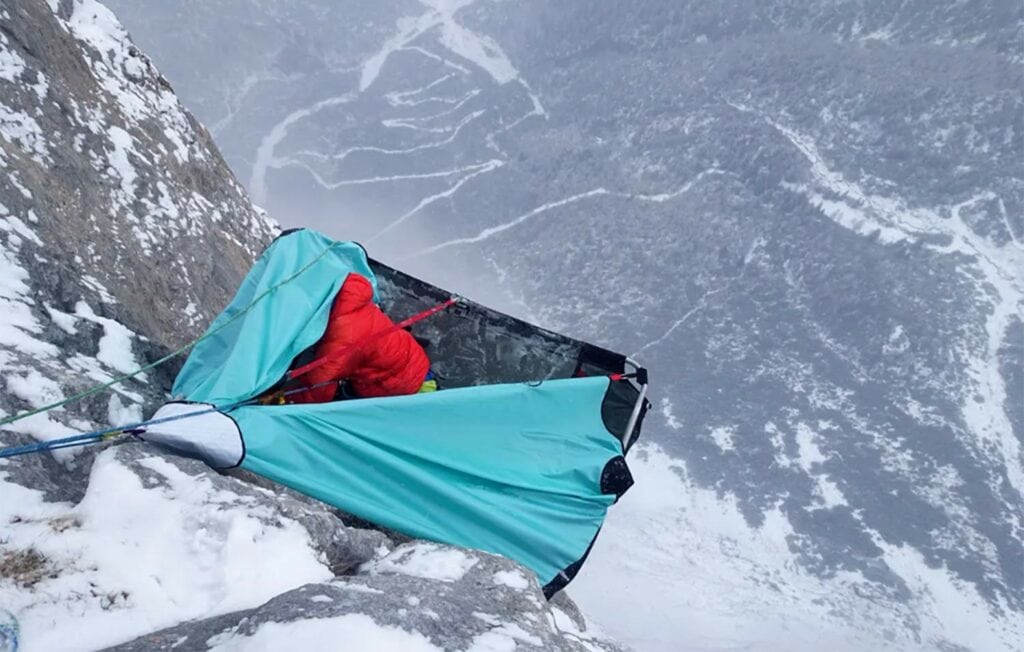How Rock Climbers Sleep: An Intro to Portaledges (2024)

Published on: 04/23/2022
Have you ever wondered how rock climbers sleep when on a big wall climb? Like El Cap in Yosemite National Park, many big walls require multi-day excursions. Because of this, climbers have no choice but to spend the night cliffside, and they need specialized gear to stay safe while sleeping.
Vertical camping is camping on the edge of a cliff using a piece of equipment called a portaledge. Imagine yourself on a fabric-covered platform surrounded by beautiful landscape and a clear night sky, 10,000+ feet up. What an adventure!
Portaledges are a safe and standard practice for bivouacking while climbing multipitch, big wall routes. It’s natural for anyone to have feelings of unease when thinking of sleeping on an open-air cot hundreds of feet above the ground. So let’s take a closer look at what a portalege is and how it works.
How do Rock Climbers Sleep? Portaledges!
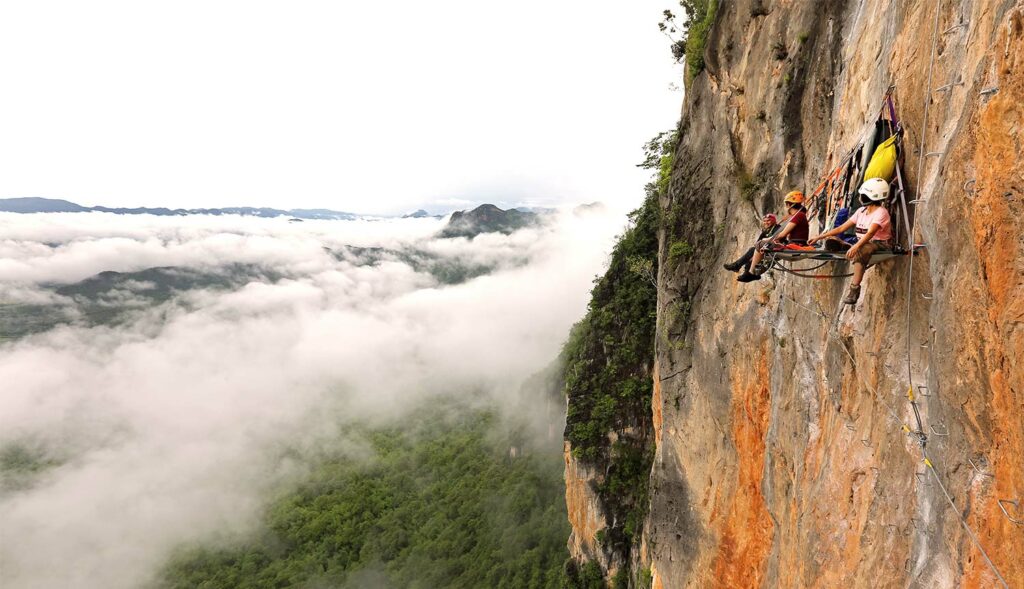
Multiday excursions require a lot of climbing and time to rest and recharge. Often, it’s hard to find a natural ledge to set up camp while on multi-day climbs. This is where a portaledge becomes the perfect remedy! They are a great gear to have while on an extended adventure. Portable ledges are not only lightweight, but they are collapsible and easy to use while suspended in the air.
What is a Portaledge?
A portaledge is a collapsible, lightweight cot used for sleeping on a vertical surface, such as the side of a cliff. Like hanging cots used in camping trailers, a portaledge is a fabric-covered platform containing a metal frame. You can assemble the frame while hanging against a rock ledge, and it’s stable enough to sleep and even stand on.
Portaledges offer climbers a safe place to sleep and climbers also use them as a storm shelter. In this case, a rain fly, similar to the outer layer of a tent, covers the portaledge during rain, or a storm. With the rain fly in place, the portaledge essentially becomes a hanging tent, thus the term, vertical camping.
Most portable ledges weigh between ten to thirteen pounds but can be as heavy as 28 pounds. The type of portaledge chosen for an excursion depends on the size needs and priorities of the climber. An average portaledge can sleep one or two people. Loops are often sewn into the straps to hold extra gear and maximize sleeping space.
The History of the Portaledge
Vertical camping began in 1958 when Warren Harding decided to sleep on a natural ledge while making his first ascent up El Capitan. During the 60s, climbers often used and secured traditional hammocks to the side of the cliff walls. This was a quick fix but brought on a lot of initial problems.
BAT
As a solution, Harding invented the B.A.T. or Basic Absurd Technology. This system comprised a hammock suspended from a single point. It solved the tipping and swaying problem experienced while using the standard two-point hammock. Although this system was helpful, these single-point hammocks didn’t provide much support, comfort, or weather protection for climbers.
The first portaledges were invented in the early 70s by Westbay and Hawkins. These initial prototypes were created using salvaged steel and stolen cots from lodges in Yosemite. Although they proved to be more comfortable than hammocks, they were heavy and not easy to carry. On top of their weight problem, they were also non-collapsible cots, so after being used, climbers often threw them off the cliff for retrieval.
LURP
Then, a new model emerged, the LURP. This assembled portaledge was developed by the Lowe Brothers and was a great deal better than the premier version. The frame was collapsible and it came with a nylon tent rainfly. The LURP carved the path for innovation in design because it was both foldable and lightweight. Jeff Lowe used his LURP on his first ascent of Half Dome, but unfortunately, it was never made available for commercial sale.
Cliff Dwellings
In 1977, Mike Graham founded his rock climbing gear company, Gramicci. Mike created an innovative, commercially sold portaledge called Cliff Dwellings. An American climber himself, Mike built and designed these portaledges out of friend’s garages and sold more than five hundred to climbers in California and Europe. The benefit of the Cliff Dwellings design was that it was incredibly lightweight and collapsed into a small bag, making them easy to carry.
Fortress
In 1979 Mike Graham, under his company name of Gramicci Products, created the Fortress, the first double occupant portaledge. This revolutionary device was lightweight, collapsible, and made vertical camping actually comfortable on big wall climbs. Shortly after this model came out, Fish Products, a small California company, began manufacturing their version of single-person portaledge.
A5 and D4
In the 1980s, the A5 portaledge was designed by A5 Adventures, a company owned by John Middendorf. This was one of the first portaledges to successfully endure severe weather in extreme locations. The new A5 design was weatherproof and stable and sold all over the world. It was later acquired by The North Face and then transferred to Black Diamond Equipment. Over time the designs were further developed and sold in three sizes, the Single, Alpine Double, and Cliff Cabana.
In 2017, Middendorf improved the A5 and produced the D4 Portaledge. This new model’s rounded tubed corners are more rigid and lighter in overall weight. It packs smaller and lighter than previous models. The Delta2p was then developed in 2020 and is a compact piece of equipment, containing a quick-to-assemble six-piece frame.
How Does a Portaledge Work?
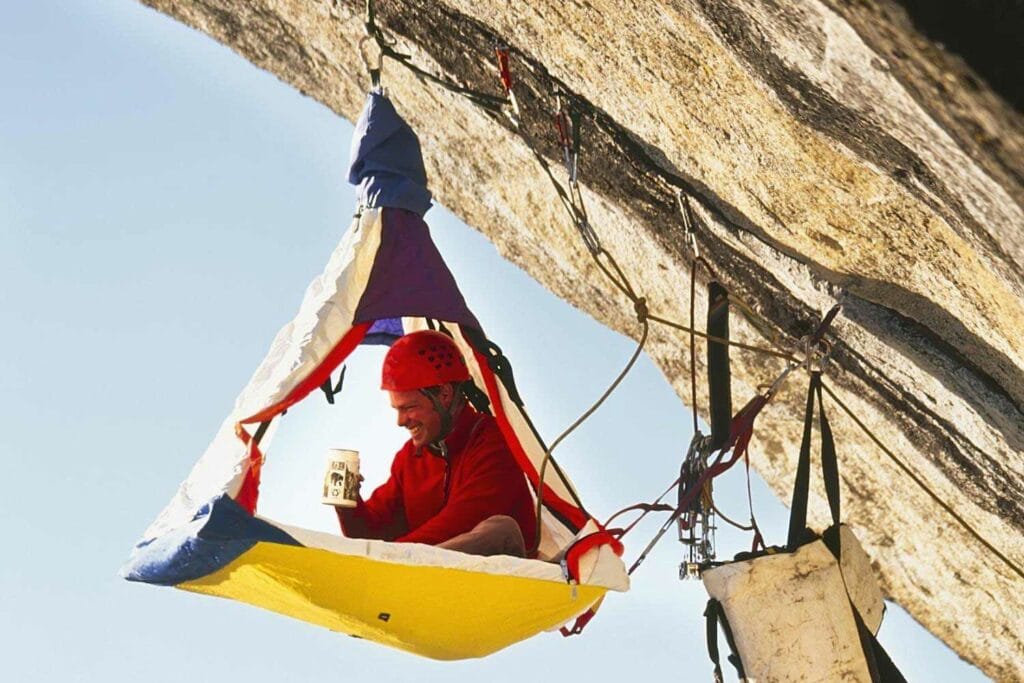
A portaledge hangs from a single point called the main anchor point. It’s suspended by four to six adjustable suspension straps and hung from the anchor point by a locking carabiner.
Often, big wall routes have various anchor points and bolts placed for portaledge use. If you find a bolt away from the main route, you’ve likely found a location meant for vertical camping.
Portaledge setup
Once you find the place you want to set up, unfold the portaledge and ensure that the straps are not twisted. Connect the frame pieces together, starting with the wall side first. While assembling the remainder of the frame, make sure to secure the corners well. If needed, try scrunching the material into the middle of the frame to help release any tension on the corners. If your portaledge has a spreader bar across the middle, make sure it’s placed properly and firmly.
Once the frame is set up, tighten the fabric using the corresponding straps. Adjust slowly and evenly to keep equal tension throughout. It’s important to keep the frame flat during this process to keep one side from pulling up with the stress of the fabric. A good portaledge should be flat and stiff.
Make sure that the adjustable suspension straps, near the bolt, are at similar lengths to the ledge will remain stable. The straps should stay as long as possible. This will allow as much room as possible for you, your gear, and anyone else participating in vertical camping.
If there’s rain in the forecast or if you like to be ready, it’s preferable to set up the rain fly at the same time that you set up your portaledge. The rainfly installs between the anchor and main locking carabiner and is made to be easily deployable.
To ensure your safety, always check that you’re effectively attached to the anchor bolt.
Important notes
If you’re planning for a multi-day climb, a portaledge is a piece of gear that you’ll have to carry with you during the entire trip. Many come with loose parts, so be aware of the possible complications when choosing your portaledge gear.
Always practice putting your portable ledge together before leaving for your trip. The rain fly is an important option to consider when purchasing a portaledge. In the chance a storm rolls in quickly, you’ll want to be able to put up your gear and rain fly quickly and efficiently.
When do Rock Climbers Sleep on their Ascent on Big Wall Climbs?
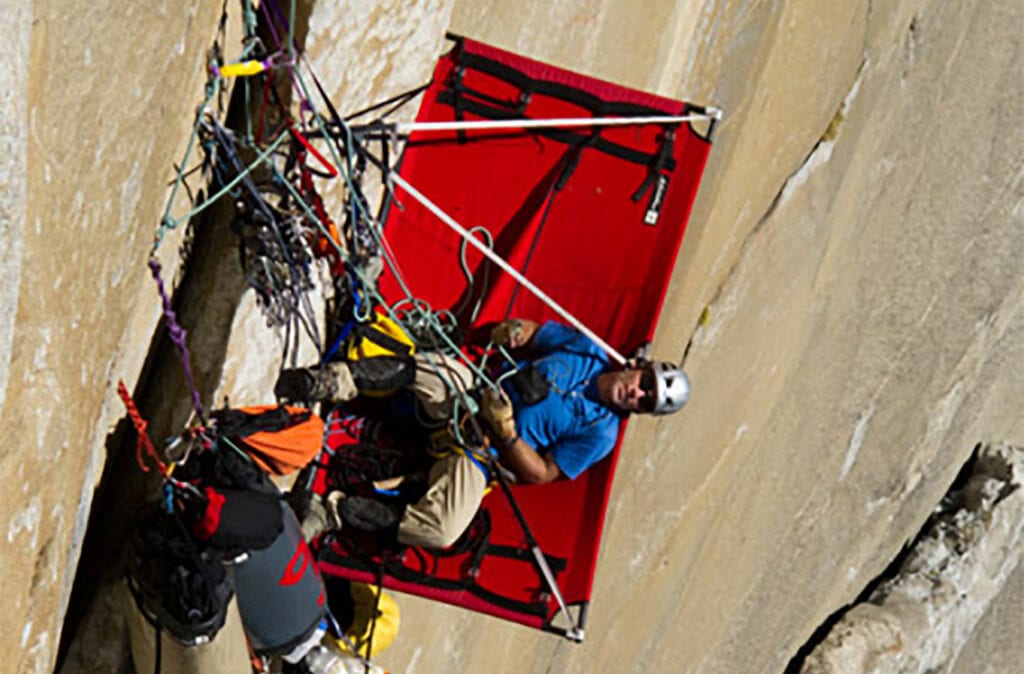
Cliff camping or vertical camping is a common activity for experienced climbers. A serious rock climber may spend multiple days on rock walls and needs ample time to relax, eat, and sleep in between climbs.
Well-known rock climbers, like Alex Honnold, make big walls look much easier than they really are. Honnold is famous to complete a big wall within a few hours while most rock climbers spend multiple days accomplishing the same route.
Many rock climbers have to sleep between climbs if they are unable to finish the ascent within a day’s time. Some climbers prefer to do half or a third of the way and spread their journey out in segments. The time or amount of days a climber spends on a big wall is really up to personal performance and preference.
Notable Climbing Spots where Sleeping is Necessary
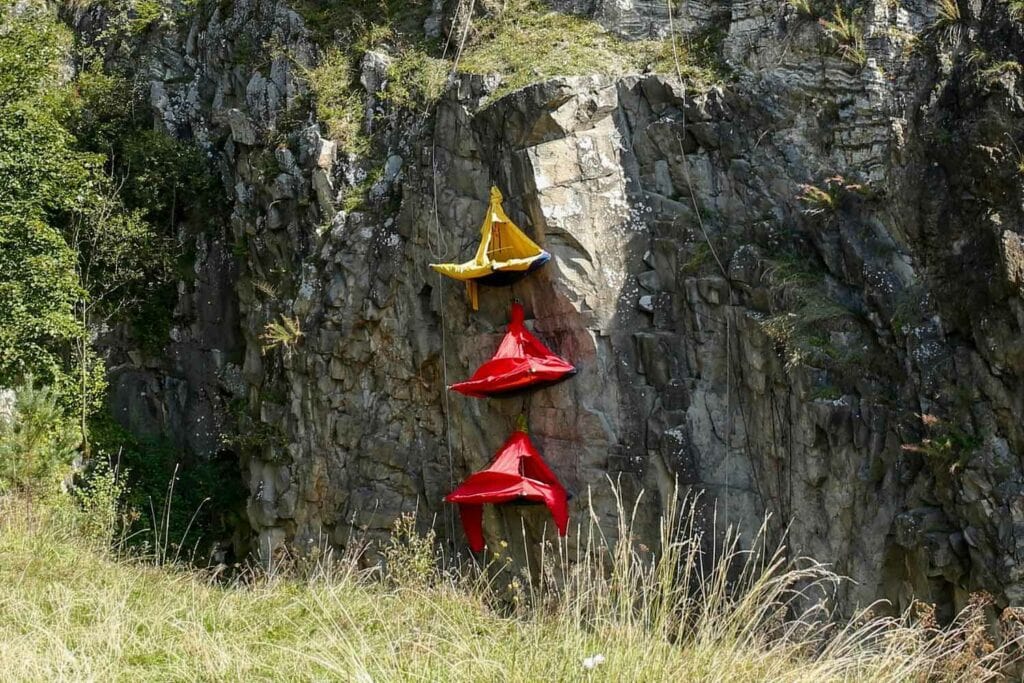
Not all climbing routes will require cliff camping. A big wall climb is a multi-pitch climb that takes more than one day to complete. Many big wall routes, like those you’d find in Yosemite National Park, Patagonia, or the Dolomites, have multiple pitches that require multiple days of climbing.
This type of climb will likely require camping on the side of a cliff. Here are a few notable walls around the world where vertical camping is necessary:
Yosemite Valley
Routes in Yosemite National Park, including El Capitan and Half Dome, are high on many climbers’ wish lists. Yosemite has some of the best big walls that are perfect for vertical camping. The Shield wall, Half Dome, the Dawn Wall, Washington Column, and Leaning Tower are all great walls to camp on during multi-day climbs.
Keep in mind that it’s not permitted to sleep at the base of El Capitan or any other big walls in Yosemite Valley, but you’re welcome to enjoy vertical camping at any time during your climbing.
Camping at the base of any backcountry walls, like Half Dome, is allowed with a valid permit.
The Dolomites
Located on the Austrian Italian border, the Dolomites call to many climbers. Most routes in this mountain range take less than a day to climb, but there are a few routes, that require vertical camping with a portaledge. Marmolada is the highest mountain in the Dolomites and sits at just under 11,000 feet up. The south wall of Don Quixote and the north wall of Cima Grande tower are great multiday excursions on Marmolada Mountain.
Norway’s Troll Wall
The Troll Wall is Europe’s tallest vertical rock wall. Trolldom, Swedish, Raspberry Dream, and Troll’s Wife are great big walls, multiday climbs for portaledge camping.
Tips for a Good Night’s Sleep on a Portaledge
If this is your first time using a portaledge, no worries! First, practice setting up camp on a tree, a safe distance from the ground. The more familiar you are with your portaledge, the easier it will be to set up and use in real-time. I recommended you go with an experienced climber, especially if it’s your first time.
Be sure to set up your hanging cot before dark. Having a climbing buddy with you is ideal, but not necessary. A portaledge can be set up by one person. The goal is to assemble it as evenly, steadily, and sturdy as possible. This will take some trial and error. If with a partner, its best to communicate when you’re moving your weight or removing yourself from the portaledge to keep your partner from getting a nice jolt with the quick movement. Getting it set up just right is key for comfort and ease of sleep.
Many portaledges come with a center divider. When you’re ready to sleep, attach the center divider and pull it taut. This will keep the sleeping space flat and comfortable throughout the night. It may be alarming sleeping at extreme heights on the edge of a cliff, but know you are completely safe as long as your rope and harness are clipped into an anchor bolt.
Don’t forget to take a look around at the scenery around you, and enjoy a view that not many people in the world get to encounter.
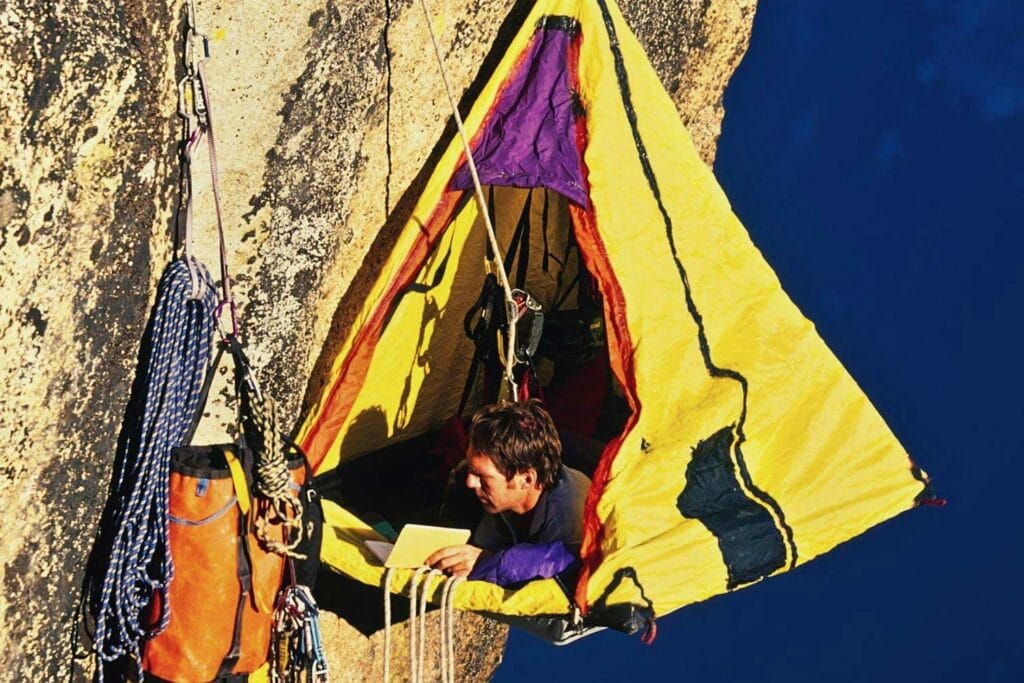
Frequently Asked Questions (FAQs)
Yes! You will always be clipped in to your harness that is connected to the main anchor at all times. Rest assured, you will not fall!
Portaledges are attached using a single anchor point. The cot is then supported by four to six straps, or suspension points, off the main anchor. The portaledge is fully attached and supported by the anchor on the cliff wall.
If you’re vertical camping, cliffside, for a night or two, you’ll likely have to go to the bathroom before getting back on solid ground. For this, rock climbers use something called a poop tube which is basically a PVC pipe sealed at both ends. After doing your business into a bag, you simply place it into the resealable tube that is then carried with you and disposed of after getting off of the wall. Although it is relatively uncomfortable to use, these sealable bags are durable and helpful when you have to go to the bathroom 10,000 feet up.
Vertical camping is a once-in-a-lifetime experience and one you should not miss out on if you get the chance. You may be surprised at how much you really enjoy the entire experience and there’s no doubt you’ll walk away with some amazing climbing stories to tell.
Are you looking for a portaledge for your next big wall climb? Check out our selection of the 5 best portaledges in 2024.

